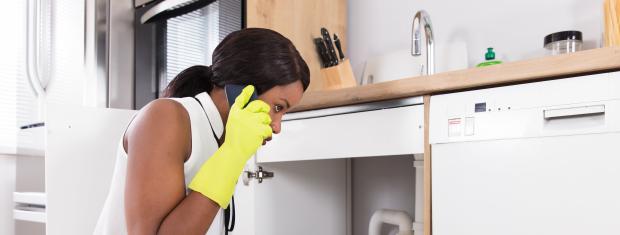
How to Detect a Water Leak in Your Home
We’ve all heard the horror stories - a water leak goes undetected for months on end and results in tens of thousands of dollars in damage once it’s finally found! A leak in your water line can be very costly, so it’s important to know the signs of a water leak in your home and some simple techniques to try on your own before contacting a professional plumber:
The Signs
1. Increase in Your Water Bill
This is a tell-tale sign that you may have a hidden water leak on your property. To ensure the spike is not caused by a seasonal change, you’ll need to keep track of your water bills and your average use. If you find that your water bill has consistently gone up for several months, there is a good chance you have a leaky pipe in your home.
2. Water Meter Fluctuations
Monitoring your water meter is a great way to detect a leak in your home:
- Shut off the water, including your washing machine, dishwasher and all faucets.
- Check your water meter to see if it begins to move immediately. If it does, you likely have an aggressive leak somewhere. On the contrary, if it doesn’t move for a few hours, you likely have a slow leak in your home. If it doesn’t move at all after you shut off the water, you can breathe a sigh of relief!
3. Appearance of Mold and Mildew

While mold is most common around bathtubs, the appearance of mildew in other areas of your home could be the sign of a leak. Leaks often cause surrounding areas to accumulate moisture, hence the onset of mold.
Mold can be on the floor or the ceiling. It often leaves a musty odor, so if you’re a clean freak and continue to smell something funky, there may be a leak somewhere. If you see mold in your home, especially black mold, we recommend calling a professional plumber right away as this level of mold could be a health hazard.
4. Damaged Materials
Water leaks can cause visible damage to paint, wallpaper, walls and flooring. Leaks often leave stains on ceilings as well.
Locating the Source of the Leak
Home plumbing systems are quite sophisticated. The more you can do to make the plumbers job easier, the more money you’ll save in the long run. Here are some of the common places you can check to find the source of the leak before contacting a professional:
Hot Water Tanks

Check the pressure relief valve on the hot water tank itself. Sometimes these valves are plumbed directly into a drain that could be leaking without your knowledge. If you can’t remove the drain pipe to check for a leak, listen for a hissing sound that indicates it might be leaking.
Toilets
Check the toilet for leaks by removing the top off the tank and listening very closely. If you hear any hissing at all, try to locate where it is coming from.
Hose Bibs
Hose bibs are located on the outside of your home, these are the pipes you connect your hoses to.
- Once you have located them, take a screwdriver and put the metal tip of the screwdriver directly on the metal part of the hose-bib. Put your thumb knuckle on the top of the screwdriver, and then place your knuckle on the side of your head, immediately in front of your ear. The sound will travel directly to your eardrum. The idea, here, is for the solid screwdriver to work like a stethoscope. This works for most metal valves, as well.
- Listen carefully for any sound emitting from the hose-bib. If you hear anything at all, remember where it is (perhaps mark it with chalk), and go to the next one. If the sound emitted gets louder at any of the other hose-bibs, then the leak is closer to that particular unit. Note that and contact your plumber: Giving the plumber this information will save the plumber loads of time in finding the leak, which in turn saves you money.
Meter Line
- If you know you have a shut-off valve by the house, shut it off temporarily and check the meter by removing the lid and watching the dial on the top of the meter.
- If you can’t see the meter head, try digging around. They sometimes have dirt or grass covering the top. Once you locate it and ensure that it is turned off, watch the meter to see if it is turning. If it is still turning, then the leak is between the meter and the house! That is, unless you have a leaking valve, which is common with older bronze gate valves. If this is the case, your leak may also be inside the house.
- At this point, walk around the area between the meter and shut-off valve, looking for signs of a leak. These include:
- soft muddy areas
- grass that is greener than the rest or growing more rapidly than other areas
- If you have the valve shut off at the house and the meter has stopped moving, this indicates that the leak is somewhere in the house.
Shower Head

This should be a fairly easy home repair if this is the source of the leaking.
Preventing Water Leaks in Your Home
Inside
- Check appliances regularly
- Replace your washing machine hoses regularly
- Install water detection devices
- Check your water pressure frequently
- Monitor your water bill for sudden spikes
Outside
- Disconnect hoses/shut off water to outside pipes before cold weather hits. The onset of frozen pipes begins when temperatures fall below 20°f
- Clean gutters and downspouts
- Maintain trees and vegetation
Experiencing a water leak in the home can be pesky indeed. If you have trouble locating the leak or repairing it on your own, you should contact a professional immediately to stop the leak from spreading and further damaging your property.


